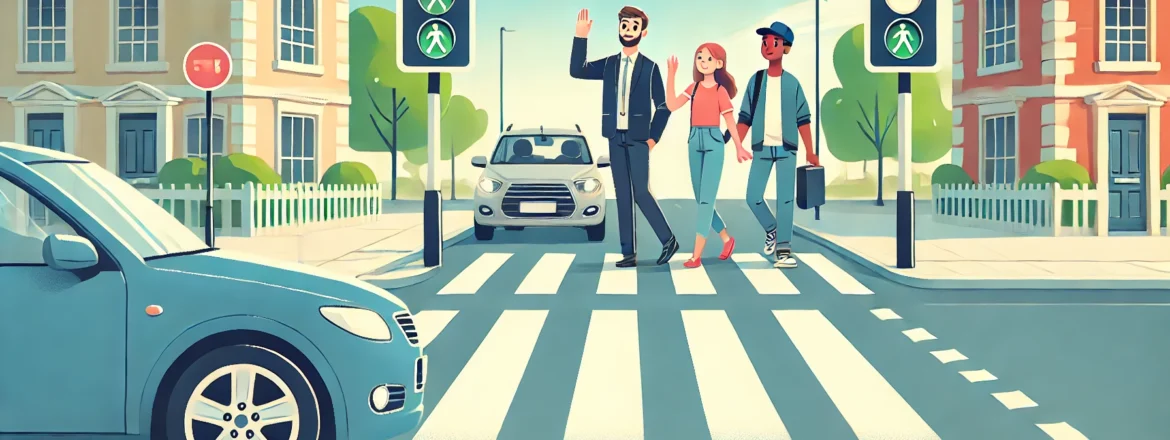Mastering pedestrian crossings is essential for passing your driving test. Safe pedestrian crossing skills demonstrate your awareness, control, and adherence to traffic rules. This guide will help you navigate pedestrian crossings with confidence and precision during your test.
Table of Content
- Importance of Pedestrian Crossings
- Types of Pedestrian Crossings You Need to Know
- Key Rules for Pedestrian Crossings During a Driving Test
- Step-by-Step Guide to Handling Crossings
- Common Mistakes to Avoid
- Practice Tips for Success
- FAQs About Pedestrian Crossings in Driving Tests
Importance of Pedestrian Crossings
Pedestrian crossings ensure road safety for both drivers and pedestrians. During your driving test, you must show the examiner that you understand and respect pedestrian priority. Proper crossing handling is a critical part of the K53 driving test.
Types of Pedestrian Crossings You Need to Know
Understanding the different types of crossings is vital for success. Here are the common types:
1. Zebra Crossings
- Marked with white stripes across the road.
- Pedestrians always have the right of way.
- Drivers must stop when pedestrians are present.
2. Signal-Controlled Crossings
- Pedestrian crossings equipped with traffic lights.
- Follow the signals; stop when the light is red for vehicles.
3. School Crossings
- Often supervised by school wardens with signs.
- Always stop if the warden signals you to.
4. Unmarked Crossings
- Areas where pedestrians frequently cross but lack markings.
- Approach cautiously and yield to pedestrians.
Key Rules for Pedestrian Crossings During a Driving Test
- Slow Down Approaching Crossings
Always reduce speed when approaching crossings to show control and caution. - Look Both Ways
Check for pedestrians on both sides of the road, even if the crossing appears clear. - Yield to Pedestrians
If pedestrians are on or near the crossing, you must stop. - Obey Traffic Signals
Ensure you follow traffic lights and crossing signals without hesitation. - Do Not Block Crossings
When waiting at intersections, avoid stopping on a crossing.
Step-by-Step Guide to Handling Crossings
Follow these steps to handle crossings correctly:
Step 1: Observe Early
As you approach a crossing, scan for signs, road markings, and pedestrians.
Step 2: Adjust Speed
Decelerate smoothly and prepare to stop if necessary.
Step 3: Look for Pedestrians
Check for people waiting to cross. Make eye contact to show awareness.
Step 4: Stop If Necessary
Stop at the line and allow pedestrians to cross fully before proceeding.
Step 5: Check Again Before Moving
Before resuming, check for late-arriving pedestrians or potential hazards.
Common Mistakes to Avoid
Avoid these mistakes to ensure a smooth test experience:
- Failing to slow down near crossings.
- Not yielding to pedestrians on the crossing.
- Blocking the crossing with your vehicle.
- Ignoring pedestrian crossing signals.
- Moving too soon before the crossing is clear.
Practice Tips for Success
1. Practice on Real Roads
Visit areas with multiple crossing types to build familiarity.
2. Learn the K53 Rules
The K53 exam emphasizes safe pedestrian handling, so study this section carefully.
3. Drive with an Instructor
A female driving instructor near me or other professionals can guide you on crossing techniques.
4. Review Traffic Signs
Understanding pedestrian crossing signs ensures you anticipate them better.
FAQs About Pedestrian Crossings in Driving Tests
1. Do I always need to stop at a zebra crossing?
No, only if pedestrians are present or approaching the crossing.
2. What happens if I fail to stop for a pedestrian?
Failing to yield is considered a serious offense and could lead to test failure.
3. How can I tell if a pedestrian intends to cross?
Look for body language, eye contact, or gestures indicating their intent.
4. Can I stop on a pedestrian crossing during heavy traffic?
No, blocking a crossing is unsafe and may result in test penalties.
Final Thoughts
Mastering pedestrian crossings is a critical skill for passing your driving test. Regular practice and a focus on safety will help you approach crossings with confidence. Remember to stay calm, follow the rules, and prioritize pedestrian safety.


